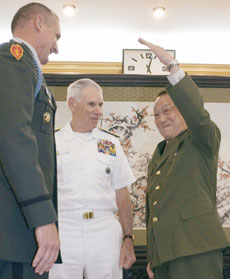The commander of US forces in the Pacific, Admiral
William Fallon, has invited Chinese officers to observe US-led joint military
exercises next summer near the Pacific island of Guam, a move pointing toward a
warming-up of the military ties between the two Pacific powers.

Chinese Defence Minister General Cao Gangchuan
(R) measures an unidentified U.S. military officer as the commander of
U.S. Pacific Command Admiral William Fallon (C) looks on during a meeting
in the Chinese Ministry of Defence in Beijing May 10, 2006.
[Reuters] |
Admiral Fallon is reportedly having flashed a broad grin as he sat in the
cockpit of a twin-engine FB-7 fighter-bomber, China's most advanced domestically
produced warplane in Hangzhou, East China's Zhejiang Province.
"They had to drag me out of there," recalled Fallon, a veteran carrier pilot,
as he described the first such close look by a US official of the modern
two-seater, which is scheduled to become a key part of China's air defenses.
According to a Washington Post report, Fallon's visit to China's 28th Air
Division, based near Hangzhou, and his pilot's inspection of the newly deployed
FB-7 were high points in a week-long tour of Chinese military installations and
meetings with senior officers, including Defense Minister Cao Gangchuan.
At a windup briefing in Shenyang, Northeast China's Liaoning Province,
Monday, Fallon said the visits marked a significant step forward in his drive to
increase contacts between the US and Chinese militaries as a way to dissolve
suspicions and reduce chances that the two powers will go to war.
"They really went out of their way to accommodate nearly everything I wanted
to do," he said. The goal, he added, is to push for more contacts, "to see more
things and different things, and to be more open and transparent in military
matters," the Washington Post reported
Seeking to accelerate the movement, Fallon said, he invited senior Chinese
officers to observe the upcoming military drills near the Guam, promising them
the opportunity to review US bases and board US warships during air-sea drills.
Implicit in the invitation, he added, was the idea that, if the Chinese
attend, they would reciprocate by inviting US officers to observe future Chinese
exercises "in a manner we would like to make a standard for both countries."
"That's what this is all about," he said, adding: "There are extensive
contacts in every area. The one lag, the one exception, is in
military-to-military contacts. We set out last year to right that."
Fallon said during his 90-minute discussions with General Cao, who is vice
chairman of the Central Military Commission, he was asked why the Pentagon, in
its recent Quadrennial Defense Report, suggested China is the country with the
greatest potential to pose a challenge to the US military in the future.
"As we discussed these items, it struck me that we have a long way to go,"
Fallon said.
The United States and China cut off military contacts in 2001 after a US Navy
EP-3 surveillance plane and a Chinese fighter collided over the South China Sea,
killing a Chinese pilot and forcing the US aircraft to make an emergency landing
on China's Hainan Island.
Since taking over as head of the Honolulu-based US Pacific Command in
February 2005, Fallon has campaigned to restore and strengthen the ties, seeking
to multiply contacts at all levels of the two countries' military hierarchies.
Cao also endorsed restoring and expanding military-to-military relations,
telling the New China News Agency that they are "an important part of
bilateral relations." But he did not immediately respond to Fallon's invitation
for Chinese officers to observe next summer's Valiant Shield exercises around
Guam.